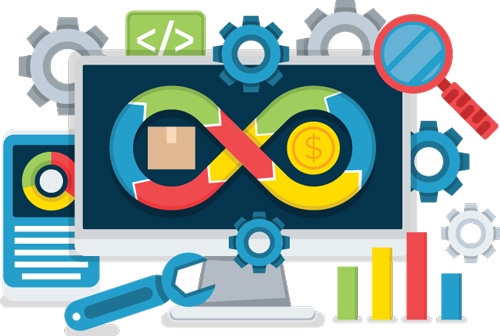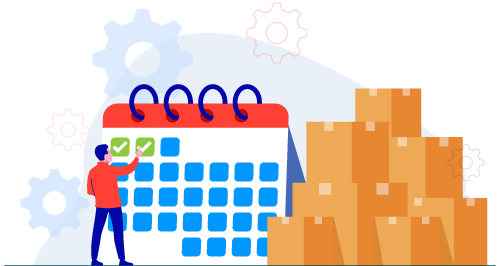What is an Order Processing System?
Built For


- The workflow of an order processing system
- Key components of an order processing system
- Benefits of an efficient order processing system
What is an Order Processing System?

Have you ever wondered how that nifty little gadget you ordered online ends up on your doorstep so quickly? It’s not magic—it’s the wonder of an efficient order processing system. Imagine it as the backstage crew of an e-commerce concert, where every piece of the puzzle has to fit perfectly to create a seamless shopping symphony.
An order processing system is the heartbeat of any product-centered operation, online or offline – and most likely both these days. It’s a complex dance of various tasks, from the moment you click “Buy” to when you’re unwrapping your purchase. An order processing system ensures that your order is taken, verified, filled, shipped, and delivered with precision. And in today’s fast-paced world where customers anticipate fast delivery speeds, having a robust system is not just nice to have; it’s an absolute must.
But what exactly goes into this system? It’s about more than just moving products from A to B. It’s about integrating inventory management, customer relationships, payment gateways, and logistics into a smooth conveyor belt of operations. It’s data, it’s human touch, it’s technology—all rolled into one.
The Workflow of an Order Processing System
Let’s take a peek behind the curtain of the magical world of order processing systems—a journey from the moment an order is placed to the unboxing by the customer.
Order Placement
Picture this: You’re lounging on your couch, scrolling through your phone, and bam! You find something you love. With a few taps, you’ve placed an order. It is simple, but the behind-the-scenes action is just getting started. The system springs to life, capturing your order details and personal info and securely tucking them into the digital cart. The eCommerce platform or a marketplace typically handles this first part of the order process.
Order Verification
Next up is the verification stage. It’s like a club bouncer checking IDs and ensuring everything’s legit. Here, the system checks the product availability, confirms prices, and verifies your payment. The verification phase of the order process is also typically handled by the website eCommerce platform or a marketplace. The inventory information is constantly updated by synchronization with a centralized order processing system.
Order Fulfillment
Now, we’re at the heart of the operation. The order is received in the centralized order processing system. Your product is picked from a shelf at the fulfillment center, given a once-over to ensure it’s perfect, and then packed with care and a packing slip.
Order Shipping
Once your item is snug in its box, it’s all systems go for shipping. Depending on the urgency, it could jet off via express or take the scenic route with standard shipping. The order processing system keeps tabs on it, updating you with tracking emails as your package makes its way to your doorstep.
Delivery and Confirmation
Finally, your order arrives at your doorstep, often with a satisfying thud that heralds its arrival. But the order processing system’s job isn’t complete. The system confirms delivery, making sure you received your goods.
Returns
And when you think the show is over, there’s an encore—returns management, affectionately known in the biz as RMAs (Return Merchandise Authorizations). Not every story has a fairy-tale ending with the customer and product living happily ever after. Sometimes, things need to go back, and that’s okay! RMAs are the system’s way of handling changes of hearts or mishaps. The order processing system manages the return process, ensuring it’s as hassle-free as the original purchase, keeping track of inventory adjustments and customer communications. This final act of the order processing system ensures that every experience, even those that go in reverse, is positive and efficient.
And that, my friends, is the order processing system workflow. From a simple click to the physical product in your hands, it’s a complex dance of technology, logistics, and some human care that makes online shopping easy.
Key Components of an Order Processing System

A review of the anatomy of an order processing system reveals the gears and cogs that keep the e-commerce engine running smoothly. Let’s break down these essential components, shall we?
Multi-channel Order Management
These days, sales may occur at a variety of places – eCommerce sites, marketplaces, sales teams, EDI, or by phone, fax, email, or even mail. A centralized order processing system is the center of it all, processing all orders with the same precision, regardless of where the order originated.
Inventory Management
Imagine trying to make an epic sandwich without knowing if you have bread or not—that’s a no-go, right? Inventory control is the bread and butter of order processing – it’s all about knowing what you have, where it is, and how much you need. Inventory management keeps track of every product, constantly in sync with sales, to ensure no customer faces the heartbreak of an out-of-stock message.
Customer Relationship Management (CRM)
Now, let’s talk about keeping customers happy. CRM is the component of the order processing system that maintains all customer information and interactions. It’s a central repository for everyone in the company to access to help any customer with the same, up-to-date information.
Payment Processing
The cha-ching moment! Payment processing is where the magic of making money happens. It’s a secure vault, guarding customer payment information and transactions, juggling different payment methods, currencies, and even those pesky tax calculations, making sure every penny is accounted for.
Shipping and Delivery Management
Shipping and delivery management is the globe-trotting expert, managing the carrier and delivery options, ensuring each purchase is shipped via the method preferred by the customer, and efficiently getting orders out the door from Point A to Point B.
Data Analysis and Reporting
Finally, let’s spotlight the data wizards—analysis and reporting tools. This component of the order processing system digs into the nitty-gritty of sales data, customer behavior, and operational efficiency. It is the brain that learns from patterns, making sense of numbers to pave the path for more intelligent business decisions. Think of it as the Sherlock Holmes of your e-commerce platform, always solving the mystery of “How can we do better?”
QuickBooks Integration
An order processing system integrated with QuickBooks allows the seamless flow of financial data between sales, operations, and accounting. With QuickBooks in the mix, every sale, expense, and inventory change is automatically recorded—no more manual entries or midnight math. QuickBooks integration saves time and paints a real-time portrait of your financial health, helping you confidently make decisions. Whether you’re a small online business or a growing enterprise, QuickBooks integration with your order processing system turns the complexity of financial management into a walk in the park, giving you more time to focus on what you do best—running your business.
Each of these components is crucial for the smooth operation of an order processing system, acting like a well-oiled machine to power the heartbeat of e-commerce. Together, they create a symphony of efficiency that’s music to any business owner’s ears.
Benefits of an Efficient Order Processing System

Next, let’s review some of the standout benefits of an efficient order processing system.
Improved Customer Satisfaction
Top of the list, and for good reason, is customer satisfaction. Imagine your customers’ joy when orders zip out of the warehouse at lightning speed, arrive on time, and are safely packaged with the correct contents. This service gets you rave reviews and repeat customers who stick around like loyal fans at a sold-out concert.
Streamlined Internal Operations
Next, we have the internal harmony that comes from streamlined operations. It’s like conducting an orchestra where every section is in perfect harmony—the violins of inventory, the cellos of CRM, and the trumpets of shipping all play in sync. This symphony of efficiency means less chaos, fewer errors, and a more productive team.
Better Inventory Control
A solid order processing system gives you complete oversight of your inventory. You’ll know what’s flying off the shelves and what’s gathering dust, so you can make intelligent buys and avoid the dreaded overstock or stockouts. It’s like being a master chess player, constantly several moves ahead of the game.
Enhanced Data Accuracy and Decision-Making
With a data analysis powerhouse at your fingertips, making informed decisions becomes as easy as pie. You get clear insights into what’s hot and what’s not, where you’re nailing it, and where there’s room for improvement. It’s like having a crystal ball but for business strategy.
Increased Sales and Profitability
Lastly, the crown jewel of benefits is boosting your bottom line. When the rest of the benefits come together, they pave a golden road to increased sales and profitability. An order processing system is the difference between a trickle of profits and a flowing river of financial success.
In short, an efficient order processing system doesn’t just make life easier—it elevates your business to new heights, turning first-time buyers into lifelong patrons and daily operations into a well-choreographed ballet of productivity and profit.
What is an Order Processing System? FAQs
What is an order processing system?
An order processing system is a combination of software and processes that handles everything from order entry to the packaging and shipping of a product to the customer. An order processing system streamlines the sales process, ensuring efficiency, accuracy, and speed, ultimately leading to a better customer experience and higher sales.
How does an order processing system improve customer service?
An order processing system enhances customer service by ensuring that orders are accurate, inventory levels are updated in real time, and products are shipped and delivered promptly. It also allows for smooth returns and exchanges and gives customers timely updates about their order status.
Can small businesses benefit from an order processing system?
Yes, absolutely. Small businesses benefit significantly from an order processing system as it can automate many tasks that would otherwise consume much time and resources. This automation allows businesses to focus on growing their business rather than getting bogged down in order processing details.
What features should I look for in an order processing system?
When selecting an order processing system, look for features like inventory management, customer relationship management (CRM), payment processing, shipping and delivery management, and data analysis and reporting. Additionally, consider ease of use, integration capabilities with popular eCommerce platforms and QuickBooks, and scalability to grow with your business.
Call us at 817-870-1311




